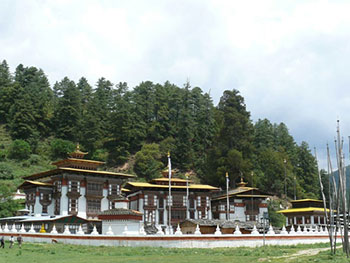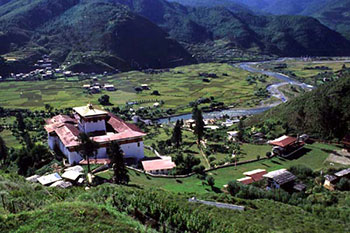culture of bhutan tour
Duration : 12 Nights / 13 Days
Destinations : Paro – Thimphu – Phobjikha - Choekhor Valley - Bumthang Region - Choekhor Valley – Trongsa - Punakha Valley - Paro Valley - Chele La - Haa Valley Excursion – Paro Valley – Departure
Culture of Bhutan Tour brings out the best of this Buddhist kingdom in a unique way. The journey is designed to accentuate the signature experiences of Bhutan through excursions and treks.
Day 1. Paro Airport to Thimphu City (1 hrs 30mins)
After clearing immigration and customs, meet Destinations Beyond India representative for assisted transfers to Bhutan’s capital Thimphu. Check in hotel and have lunch. Enjoy the remainder of the day to explore Thimphu in a classic way. Walk your way through the special Craft Bazaar or brush up your general knowledge with a visit to National Memorial Stupa. Marvel at the woven textile forms in the National Textiles Museum. Be amused while observing the indigenous Takin, the national animal in the Takin Preserve. Choice is entirely yours which one you like to enjoy first. Overnight Thimphu.
Day 2. Sightseeing in the Thimphu Valley today.
Visit National Library to witness a vast collection of ancient Buddhist manuscripts. The weekend market (Fri-Sun) is a colourful affair where one can see impressive range of organic vegetables, fruits and particularly red chillies, cups of butter tea, turquoise from Tibet, and musical instruments etc. Overnight Thimphu.
Day 3. Thimphu to Phobjikha Valley (5 hours)
When the ruins of the Wangdue Phodrang Dzong (tragically destroyed by fire in June 2012)come into view, notice the large cacti that cover the hillside below which, were planted long ago to discourage invaders from climbing the steep slope to the Dzong. From the road view Rinchengang, one of Bhutan’s oldest villages, which did not have access to water, electricity or schooling until the early 1990’s.The craftsmen of Rinchengang are sought after for their skills in construction of Dzongs and Lhakhangs (temples).
Until recently the Phobjikha valley’s only electricity came from solar or mini hydro plants. In 2011 underground cabled electricity is gradually connecting the valley to the national grid. Potatoes are this region’s primary cash crop and mainly exported to India. Phobjikha is a glacial valley on the western slopes of the Black Mountains and is one of the most beautiful open valleys in Bhutan. It is also one of the most important wildlife preserves in the country and the winter home(late October to early February) of the rare black necked crane, which annually flies in from Tibet. There are also muntjaks (barking deer), wild boar, sambar, Himalayan black bear, leopard and red foxes. Overnight Phobjikha Valley – Bhutanese Style 3* Hotel.
Day 4. Sightseeing in the Phobjikha Valley today.
While you are in Phobjikha you will visit the Black Crane nature information centre, the carpet factory (optional) and the sacred Gangtey Monastery plus enjoy time to wander through Gangtey village and hike the Gangtey Nature Trail. There are many additional hikes available in this beautiful valley and your guide will advise you the best options. Overnight Phobjikha Valley - BhutaneseStyle 3* Hotel.
Day 5. Phobjikha Valley to Choekhor Valley (4 hrs 30mins)
This morning depart Phobjikha to the central Bumthang region comprising the 4 valleys Choekhor, Tang, Ura and Chhume. Traverse the Pele La (Pass) which crosses through the Black Mountains National Park and divides western and central Bhutan and stop for lunch near Trongsa, where you will spend more time on your return journey. Keep a watchful eye out for Rhesus Macaques (Brown Monkeys) on the side of the road. The Trongsa Dzong is perched at the end of a ridge and seems to hang in space at the head of the valley. The Dzongs location afforded it great power over this part of the country as the only foot and mule trail between east and western Bhutan leads straight through Trongsa and through the Dzong itself.
On arrival in the Bumthang region notice the large fields of buckwheat that cover the valleys…..buckwheat noodles and pancakes are a Bumthang specialty. Enjoy the remainder of the afternoon at leisure. There are short walks and hikes to choose from and your guide will be happy to make recommendations. Overnight Choekhor Valley - Bhutanese Style 3* Hotel.
Day 6. Sightseeing in the Bumthang Region.
Alternatively enjoy one of the hikes available in this region or find a nice quiet spot at the HOTEL to catch up on some reading. Overnight Choekhor Valley - Bhutanese Style 3* Hotel.
Day 7. Choekhor Valley to Trongsa (2hrs)
Today transfer back towards Trongsa via the Chhume valley for the opportunity to shop for excellent local handicrafts and textiles. This region is renowned for its exceptionally high quality weavings. The Trongsa Dzong is the ancestral home of the Royal Family of Bhutan and has added the excellent Tower of Trongsa museum into it’s ancient watchtower, which you will visit this
Alternatively there is a good 2 hour valley hike below the Dzong that your guide will advide you on. Overnight Trongsa – Bhutanese Style 3* Hotel.
Day 8. Trongsa to Punakha Valley (5 hrs)
Visit the local nunnery and, time permitting consider a very scenic excursion to either the small village of Nobgang, original home to the 4 former Queens of the 4th king, OR the small village of Talo where you can wander through the beautiful and serene gardens of the local monastery. Don’t forget the weekend MARKET if you are in Punakha on a Saturday morning. Overnight Punakha Valley - Bhutanese Style 3* Hotel.
Day 9. Sightseeing and hiking in Punakha today.
This morning visit the dramatic Punakha Dzong, which formally served as the seat of the government and is still the winter residence of the Dratsheng (Central Monk Body). This is Bhutan’s most spectacular Dzong and an excellent example of how a medieval fortress and a centre of both monastic and administrative functions, has adapted and evolved for modern day use.
This afternoon we recommend a fascinating hike to Khamsum Yulley Namgyel Chorten through fields of vegetables, rice paddies and tiny hamlets. This Chorten holds very special significance being consecrated in 1999 and dedicated to the protection of the former Crown Prince – today’s current King Jigme Khesar Namgyel Wangchuck. Overnight Punakha Valley – Bhutanese Style 3* Hotel.
Day 10. Punakha Valley to Paro Valley (4hrs +)
Depart Punakha early morning for your transfer westwards to the Paro Valley, once again traversing Dochu La, and arriving in Paro town in time for a late lunch at one of the local restaurants.
This afternoon enjoy an orientation tour of the major features in Paro town including Paro Dzong with its cantilever bridge; Kyichu Lhakhang – one of Bhutan’s oldest and most beautiful temples boasting an orange tree that perpetually bears fruit followed by a visit to the old ruined fortress of the Drugyel Dzong (14km from Paro). This is the historical site of the Fort of Drukpa Victory, from which the Bhutanese used to repel the Tibetan invaders again and again. On a clear day views of the 7314 m snow domed peaks of sacred Mt Chomolhari can be seen. Overnight Paro Valley – Bhutanese Style 3* Hotel.
Day 11. Sightseeing in the Paro Valley.
This afternoon check out the National Museum in Paro to view the fine collection of ancient Thangkha paintings, textiles, weapons and other artefacts and we recommend a wander along the main street which OFFERS good shopping for jewellery and handicrafts. Overnight Paro Valley – Bhutanese Style 3*Hotel.
Day 12. Chele La and Haa Valley Excursion
Travel to Chele La (pass) on Bhutan’s highest motorable road at 3980 m and choose to take an awesome ridge hike to the Kila Nunnery or continue down into the remote and hidden Haa Valley.
If taking the hiking option you will very much enjoy your interaction with the Nuns.
Haa is a most beautiful valley, only opened up to tourists since 2004, and a visit is especially recommended between March and November. During the winter months DEC-FEB the road can become impassable and during this period we recommend you substitute this day/night for an extra night in Bumthang, central Bhutan.
For those who prefer to stay at a lower altitude your guide will recommend a number of lower valley hikes in the Paro area. Overnight Paro Valley. Day 13. Early morning departure from your HOTEL to Paro Airport for your onward flight.
